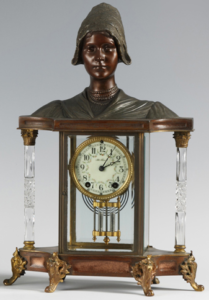 Deb asked a question that’s way over my head. Bear with me because the physics of anything are not my strong suit. “My grandmother owned aa famous brand Mercury clock. ‘Mercury’ was not the brand name. ..why did she call it ‘Mercury?’” Because these clocks, usually called regulators, DID contain sealed vials of mercury. And if it happens to break you have a problem….
Deb asked a question that’s way over my head. Bear with me because the physics of anything are not my strong suit. “My grandmother owned aa famous brand Mercury clock. ‘Mercury’ was not the brand name. ..why did she call it ‘Mercury?’” Because these clocks, usually called regulators, DID contain sealed vials of mercury. And if it happens to break you have a problem….
Regulator clocks with pendulums slow down in the summer and speed up in the winter. These antique regulator clocks came with metal pendulums and a weight. The length of the pendulum gets longer in the summer which lowers that WEIGHT, the center mass, of the pendulum. This results in a slower timepiece…..
Regulator Pendulums
A little vial of the dangerous heavy metal mercury compensated for the change in the pendulum. Sometimes we spot two little sealed vials of mercury on the pendulum itself. The level of mercury rises with a temperature increase, which COMPENSATES for the summer lengthened pendulum. Clockmakers designed regulator pendulums to compensate for temperature variations. As metal gets warm it expands down. The metal (mercury) sealed in the vial has nowhere to expand but up. This supposedly kept the center of oscillation constant.
Two Englishmen invented this type of clock in the 18th century (1760-1780). The great thing about them…accuracy. They run with a swinging pendulum that COMPENSATED in the form of one or two mercury vials, making them the most accurate clock heretofore. Even though invented in England, the English didn’t fall for them with the same fervor as the Germanic folks DID. By the 19th century The Viennese Regulator became the clock of choice, found in just about every train station. Gustav Becker became the most celebrated Vienna Regular clockmaker, and his carved walnut wall mounted regulators were ubiquitous (1850- 1890). If you have a good one, it can be worth in the $800 range.
The Problem with Regulator Clocks
Back in the 19th century, if your clock ran slower or faster, someone in the household opened the sealed vials of mercury and added more or took out some drops. Perhaps at that time the man of the house who did the fiddling with the clock didn’t know about Mercury’s toxic nature! American clockmakers interested in saving money replaced the mercury in the vials with steel slugs. Thus, the more expensive clocks with four sides of beveled glass and pendulums with little weights MIGHT still hold mercury.
Clockmakers fitted many early crystal regulator clocks with mercury compensated pendulums. Including all the French clocks. They call this a “crystal regulator” because of the glass on all four sides and it’s driven by a swinging pendulum weighted. The pendulum is the regulator and in Deb’s clock, the pendulum contains two glass vials with mercury. If damaged she must replace these glass vials with faux ones as mercury is no longer readily available. American made crystal regulators used plated, or very highly polished steel slugs inserted into glass tubes to simulate this look.
Great website if you love clocks:
Check out ClockHistory.com, and the Virtual Museum “National Watch and Clock Museum.” My Favorite is the Detex Watchman’s Clock Album, which tells and illustrates the story of watchmen’s clocks. These are clocks used to make sure the watchmen (guards) watched in the places they should. They recorded time and place in the 19th century on this little strange looking portable clock with record keeping notches.
Finally, a funny thought: those of us that grew up with digital timepieces might not know what the term “Quarter to” means! Yes we might understand 11:45 and not Quarter to twelve. And the clockface might go the way of the Regulator clock that uses mercury for accuracy….